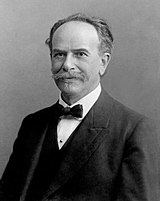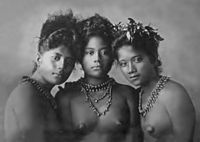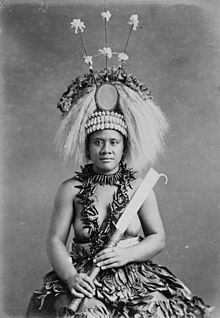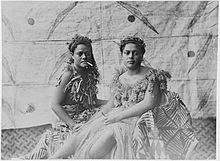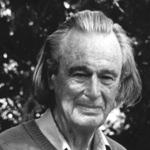
Original title page (1928)
| |
| Author | Margaret Mead |
|---|---|
| Country | United States |
| Language | English |
| Subject | Samoan culture and society |
| Publisher | William Morrow and Co. |
Publication date
| 1928 |
| Media type | Print (Paperback) |
| Pages | 297 |
Coming of Age in Samoa is a book by American anthropologist Margaret Mead based upon her research and study of youth – primarily adolescent girls – on the island of Ta'u in the Samoan Islands. The book details the sexual life of teenagers in Samoan society in the early 20th century, and theorizes that culture has a leading influence on psychosexual development.
First published in 1928, the book launched Mead as a pioneering researcher and as the most famous anthropologist in the world. Since its first publication, Coming of Age in Samoa was the most widely read book in the field of anthropology until Napoleon Chagnon's Yanomamö: The Fierce People overtook it. The book has sparked years of ongoing and intense debate and controversy on questions pertaining to society, culture, and science. It is a key text in the nature versus nurture debate, as well as in discussions on issues relating to family, adolescence, gender, social norms, and attitudes.
In the 1980s, Derek Freeman contested many of Mead's claims, and argued that she was hoaxed into counterfactually believing that Samoan culture had more relaxed sexual norms than Western culture. However, the anthropology community on the whole has rejected Freeman's claims, concluding that Freeman cherry-picked his data, and misrepresented both Mead's research and the interviews that he conducted.
Content
Foreword
In the foreword to Coming of Age in Samoa, Mead's advisor, Franz Boas, writes:
"Courtesy, modesty, good manners, conformity to definite ethical standards are universal, but what constitutes courtesy, modesty, good manners, and definite ethical standards is not universal. It is instructive to know that standards differ in the most unexpected ways."
Boas went on to point out that, at the time of publication, many
Americans had begun to discuss the problems faced by young people
(particularly women) as they pass through adolescence
as "unavoidable periods of adjustment". Boas felt that a study of the
problems faced by adolescents in another culture would be illuminating.
Introduction
Margaret Mead (ca 1930 to 1950, age 30s or 40s)
Mead introduces the book with a general discussion of the problems
facing adolescents in modern society and the various approaches to
understanding these problems: religion, philosophy, educational theory
and psychology. She discusses various limitations in each approach and
then introduces the new field of anthropology
as a promising alternative science based on analyzing social structures
and dynamics. She contrasts the methodology of the anthropologist with
other scientific studies of behavior and the obvious reasons that
controlled experiments are so much more difficult for anthropology than
other sciences. For this reason her methodology is one of studying
societies in their natural environment. Rather than select a culture
that is fairly well understood such as Europe or America, she chooses South Sea island
people because their culture is radically different from Western
culture and likely to yield more useful data as a result. However, in
doing so she introduces new complexity in that she must first understand
and communicate to her readers the nature of South Sea culture itself
rather than delve directly into issues of adolescence as she could in a
more familiar culture. Once she has an understanding of Samoan culture
she will delve into the specifics of how adolescent education and
socialization are carried out in Samoan culture and contrast it with
Western culture.
Mead described the goal of her research as follows:
"I have tried to answer the question which sent me to Samoa: Are the disturbances which vex our adolescents due to the nature of adolescence itself or to the civilization? Under different conditions does adolescence present a different picture?"
To answer this question, she conducted her study among a small group
of Samoans. She found a village of 600 people on the island of Ta'ū,
in which, over a period of between six and nine months, she got to
know, lived with, observed, and interviewed (having learnt some Samoan)
68 young women between the ages of 9 and 20. Mead studied daily living,
education, social structures and dynamics, rituals, etiquette, etc.
Samoan life and education
Mead begins with the description of a typical idyllic day in Samoa.
She then describes child education, starting with the birth of children,
which is celebrated with a lengthy ritual feast. After birth, however,
Mead describes how children are mostly ignored, for girl children
sometimes explicitly ritually ignored, after birth up to puberty. She describes the various methods of disciplining children. Most involve some sort of corporal punishment,
such as hitting with hands, palm fronds, or shells. However, the
punishment is mostly ritualistic and not meant to inflict serious harm.
Children are expected to contribute meaningful work from a very early
age. Initially, young children of both sexes help to care for infants.
As the children grow older, however, the education of the boys shifts to
fishing, while the girls focus more on child care. However, the concept
of age for the Samoans is not the same as in the West. Samoans do not
keep track of birth days, and they judge maturity not on actual number
of years alive, but rather on the outward physical changes in the child.
As a child gets bigger and stronger, he or she gets more work and
responsibility.
Mead describes some specific skills the children must learn
related to weaving and fishing, and then almost casually interjects the
first description of Samoan sexuality, saying that in addition to work
for adolescent girls: "All of her [additional] interest is expended on
clandestine sex adventures."
This comes directly after a passage where Mead describes how a
reputation for laziness can make an adolescent girl a poor candidate for
marriage, implying that for Samoans a work ethic is a more important
criterion for marriage than virginity.
Male adolescents undergo various kinds of both encouragement and
punishment to make them competitive and aggressive. Males have many
different possible jobs (e.g., "a house builder, a fisherman, an orator,
a wood carver") in the community. Status is also a balance between
prowess and achievement and appearing humble. Also, "social prestige is
increased by his amorous exploits".
For the adolescent girls, status is primarily a question of whom they
will marry. Mead also describes adolescence and the time before marriage
as the high point of a Samoan girl's life:
"But the seventeen year old girl does not wish to marry – not yet. It is better to live as a girl with no responsibility, and a rich variety of experience. This is the best period of her life."
Samoan household
The next section describes the structure of a Samoan village: "a
Samoan village is made up of some thirty to forty households, each of
which is presided over by a head man". Each household is an extended
family including widows and widowers. The household shares houses
communally: each household has several houses but no members have
ownership or permanent residence of any specific building. The houses
may not all be within the same part of the village.
The head man of the household has ultimate authority over the
group. Mead describes how the extended family provides security and
safety for Samoan children. Children are likely to be near relatives no
matter where they are, and any child that is missing will be found quite
rapidly. The household also provides freedom for children including
girls. According to Mead, if a girl is unhappy with the particular
relatives she happens to live with, she can always simply move to a
different home within the same household. Mead also describes the
various and fairly complex status relations which are a combination of
factors such as role in the household, the household's status within the
village, the age of the individual, etc. There are also many rules of
etiquette for requesting and granting favors.
Samoan social structures and rules
Samoan female ceremonial dancer (Thomas Andrew, c. 1890s)
Mead describes the many group structures and dynamics within Samoan
culture. The forming of groups is an important part of Samoan life from
early childhood when young children form groups for play and mischief.
There are several different kinds of possible group structures in Samoan
culture. Relations flow down from chiefs and heads of households; men
designate another man to be their aid and surrogate in courting rituals;
men form groups for fishing and other work activities; women form
groups based on tasks such as child caring and household relations. Mead
describes examples of such groups and describes the complex rules that
govern how they are formed and how they function. Her emphasis is on
Samoan adolescent girls, but as elsewhere she needs to also describe
Samoan social structures for the entire culture to give a complete
picture.
Mead believes that the complex and mandatory rules that govern
these various groups mean that the traditional Western concept of
friendship as a bond entered into voluntarily by two people with
compatible interests is all but meaningless for Samoan girls:
"friendship is so patterned as to be meaningless. I once asked a young
married woman if a neighbor with whom she was always upon the most
uncertain and irritated terms was a friend of hers. 'Why, of course, her
mother's father's father, and my father's mother's father were
brothers.'"
The ritual requirements (such as being able to remember specifics
about family relations and roles) are far greater for men than women.
This also translates into significantly more responsibility being put on
men than women: "a man who commits adultery with a chief's wife was
beaten and banished, sometime even drowned by the outraged community,
but the woman was only cast out by her husband".
Mead devotes a whole chapter to Samoan music and the role of
dancing and singing in Samoan culture. She views these as significant
because they violate the norms of what Samoans define as good behavior
in all other activities and provide a unique outlet for Samoans to
express their individuality. According to Mead there is normally no
greater social failing than demonstrating an excess of pride, or as the
Samoans describe it, "presuming above one's age". However, this is not
the case when it comes to singing and dancing. In these activities,
individuality and creativity are the most highly praised attributes, and
children are free to express themselves to the fullest extent of their
capabilities rather than being concerned with appropriate behavior based
on age and status:
The attitude of the elders toward precocity in ... singing or dancing, is in striking contrast to their attitude towards every other form of precocity. On the dance floor the dreaded accusation "You are presuming above your age" is never heard. Little boys who would be rebuked or whipped for such behavior on any other occasion are allowed to preen themselves, to swagger and bluster and take the limelight without a word of reproach. The relatives crow with delight over a precocity for which they would hide their heads in shame were it displayed in any other sphere ... Often a dancer does not pay enough attention to her fellow dancers to avoid continually colliding with them. It is a genuine orgy of aggressive individualistic behavior.
Personality, sexuality, and old age
Mead describes the psychology of the individual Samoan as being simpler, more honest, and less driven by sexual neuroses than the west. She describes Samoans as being much more comfortable with issues such as menstruation and more casual about non-monogamous sexual relations.
Part of the reason for this is the extended family structure of Samoan
villages. Conflicts that might result in arguments or breaks within a
traditional Western family can be defused in Samoan families simply by
having one of the parties to the conflict relocate to a different home
that is part of the household within the village.
Another reason Mead cites is that Samoans do not seem eager to give
judgmental answers to questions. Mead describes how one of the things
that made her research difficult was that Samoans would often answer
just about every question with non-committal answers, the Samoan
equivalent to shrugging one's shoulders and saying: "Who knows?"
Mead concludes the section of the book dealing with Samoan life
with a description of Samoan old age. Samoan women in old age "are
usually more of a power within the household than the old men. The men
rule partly by the authority conferred by their titles, but their wives
and sisters rule by force of personality and knowledge of human nature."
Educational problems: American and Samoan contrasts
Portrait of three Samoan girls (Thomas Andrew, c. 1890s)
Mead concluded that the passage from childhood to adulthood
(adolescence) in Samoa was a smooth transition and not marked by the
emotional or psychological distress, anxiety, or confusion seen in the
United States.
Mead concluded that this was due to the Samoan girl's belonging
to a stable, monocultural society, surrounded by role models, and where
nothing concerning the basic human facts of copulation, birth, bodily
functions, or death, was hidden. The Samoan girl was not pressured to
choose from among a variety of conflicting values, as was the American
girl. Mead commented, somewhat satirically:
... [an American] girl's father may be a Presbyterian, an imperialist, a vegetarian, a teetotaller, with a strong literary preference for Edmund Burke, a believer in the open shop and a high tariff, who believes that women's place is in the home, that young girls should wear corsets, not roll their stockings, not smoke, nor go riding with young men in the evening. But her mother's father may be a Low Episcopalian, a believer in high living, a strong advocate of States' Rights and the Monroe Doctrine, who reads Rabelais, likes to go to musical shows and horse races. Her aunt is an agnostic, an ardent advocate of women's rights, an internationalist who rests all her hopes on Esperanto, is devoted to Bernard Shaw, and spends her spare time in campaigns of anti-vivisection. Her elder brother, whom she admires exceedingly, has just spent two years at Oxford. He is an Anglo-Catholic, an enthusiast concerning all things medieval, writes mystical poetry, reads Chesterton, and means to devote his life to seeking for the lost secret of medieval stained glass. Her mother's younger brother...
Reception
On
publication, the book generated a great deal of coverage both in the
academic world and in the popular press. Mead's publisher (William Morrow) had lined up many endorsements from well known academics such as anthropologist Bronislaw Malinowski and psychologist John Watson.
Their praise was a major public relations coup for Morrow and drew
popular attention to the book. Academic interest was soon followed by
sensational headlines such as "Samoa is the Place for Women" and that
Samoa is "Where Neuroses Cease".
Impact on anthropology
For
most anthropologists before Mead, detailed immersive fieldwork was not a
common practice. Although subsequent reviews of her work have revealed
faults by the standards of modern anthropology, at the time the book was
published the idea of living with native people was fairly ground
breaking. The use of cross-cultural comparison to highlight issues
within Western society was highly influential and contributed greatly to
the heightened awareness of anthropology and ethnographic study in the
United States. It established Mead as a substantial figure in American
anthropology, a position she would maintain for the next fifty years.
Social influences and reactions
As
Boas and Mead expected, this book upset many Westerners when it first
appeared in 1928. Many American readers felt shocked by her observation
that young Samoan women deferred marriage for many years while enjoying
casual sex
before eventually choosing a husband. As a landmark study regarding
sexual mores, the book was highly controversial and frequently came
under attack on ideological grounds. For example, the National Catholic Register
argued that Mead’s findings were merely a projection of her own sexual
beliefs and reflected her desire to eliminate restrictions on her own
sexuality. The Intercollegiate Studies Institute listed Coming of Age in Samoa as #1 on its list of the "50 Worst Books of the Twentieth Century".
Critique of Mead's methodology and conclusions
Although Coming of Age
received significant interest and praise from the academic community,
Mead's research methodology also came in for criticism from several
reviewers and fellow anthropologists. Mead was criticized for not
separating her personal speculation and opinions from her ethnographic
description of Samoan life and for making sweeping generalizations based
on a relatively short period of study. For example, Nels Anderson
wrote about the book: "If it is science, the book is somewhat of a
disappointment. It lacks a documental base. It is given too much to
interpretation instead of description. Dr. Mead forgets too often that
that she is an anthropologist and gets her own personality involved with
her materials." Shortly after Mead’s death, Derek Freeman published a book, Margaret Mead and Samoa,
that claimed Mead failed to apply the scientific method and that her
assertions were unsupported. This criticism is dealt with in detail in
the section below.
The Mead–Freeman controversy
Derek Freeman
In 1983, five years after Mead had died, Derek Freeman – a New Zealand anthropologist who lived in Samoa – published Margaret Mead and Samoa: The Making and Unmaking of an Anthropological Myth, in which he challenged all of Mead's major findings. In 1988, he participated in the filming of Margaret Mead in Samoa,
directed by Frank Heimans, which claims to document one of Mead's
original informants, now an elderly woman, swearing that the information
she and her friend provided Mead when they were teenagers was false;
one of the girls would say of Mead on videotape years later:
We girls would pinch each other and tell her we were out with the boys. We were only joking but she took it seriously. As you know, Samoan girls are terrific liars and love making fun of people but Margaret thought it was all true.
Another of Mead's statements on which Freeman focused was her claim
that through the use of chicken blood, Samoan girls could and do lie
about their status of virginity.
Freeman pointed out that virginity of the bride is so crucial to the
status of Samoan men that they have a specific ritual in which the
bride's hymen
is manually ruptured in public, by the groom himself or by the chief,
making deception via chicken blood impossible. On this ground, Freeman
argued that Mead must have based her account on (false) hearsay from
non-Samoan sources.
The argument hinged on the place of the taupou system in Samoan society. According to Mead, the taupou
system is one of institutionalized virginity for young women of high
rank, and it is exclusive to women of high rank. According to Freeman,
all Samoan women emulated the taupou system, and Mead's informants denied having engaged in casual sex as young women and claimed that they had lied to Mead.
Anthropological reception and reactions
After
an initial flurry of discussion, many anthropologists concluded that
Freeman systematically misrepresented Mead's views on the relationship
between nature and nurture, as well as the data on Samoan culture.
According to Freeman's colleague Robin Fox, Freeman "seemed to have a
special place in hell reserved for Margaret Mead, for reasons not at all
clear at that time".
Moreover, many field and comparative studies by anthropologists
have since found that adolescence is not experienced in the same way in
all societies. Systematic cross-cultural study of adolescence by
Schlegel and Barry, for example, concluded that adolescents experience
harmonious relations with their families in most non-industrialized
societies around the world.
They find that, when family members need each other throughout their
lives, independence, as expressed in adolescent rebelliousness, is
minimal and counterproductive. Adolescents are likely to be rebellious
only in industrialized societies practicing neolocal residence patterns
(in which young adults must move their residence away from their
parents). Neolocal residence patterns result from young adults living in
industrial societies
who move to take new jobs or in similar geographically mobile
populations. Thus, Mead's analysis of adolescent conflict is upheld in
the comparative literature on societies worldwide.
First, these critics have speculated that he waited until Mead
died before publishing his critique so that she would not be able to
respond. However, in 1978, Freeman sent a revised manuscript to Mead,
but she was ill and died a few months later without responding.
Second, Freeman's critics point out that, by the time he arrived
on the scene, Mead's original informants were old women, grandmothers,
and had converted to Christianity,
so their testimony to him may not have been accurate. They further
argue that Samoan culture had changed considerably in the decades
following Mead's original research; after intense missionary activity,
many Samoans had come to adopt the same sexual standards as the
Americans who were once so shocked by Mead's book. They suggested that
such women, in this new context, were unlikely to speak frankly about
their adolescent behavior. Further, they suggested that these women
might not be as forthright and honest about their sexuality when
speaking to an elderly man as they would have been speaking to a woman
near their own age.
Some anthropologists criticized Freeman on methodological and empirical grounds.
For example, they stated that Freeman had conflated publicly
articulated ideals with behavioral norms—that is, while many Samoan
women would admit in public that it is ideal to remain a virgin, in
practice they engaged in high levels of premarital sex and boasted about
their sexual affairs among themselves.
Freeman's own data documented the existence of premarital sexual
activity in Samoa. In a western Samoan village, he documented that 20%
of 15-year-olds, 30% of 16-year-olds, and 40% of 17-year-olds had
engaged in premarital sex. In 1983, the American Anthropological Association
held a special session to discuss Freeman's book, to which they did not
invite him. Their criticism was made formal at the 82nd annual meeting
of the American Anthropological Association the next month in Chicago,
where a special session, to which Freeman was not invited, was held to
discuss his book. They passed a motion declaring Freeman's Margaret Mead and Samoa
"poorly written, unscientific, irresponsible and misleading". Freeman
commented that "to seek to dispose of a major scientific issue by a show
of hands is a striking demonstration of the way in which belief can
come to dominate the thinking of scholars".
In the years that followed, anthropologists vigorously debated
these issues. Notable scholars who published on the issue include
Appell, who stated "I found Freeman’s argument to be completely
convincing";
Brady: "Freeman's book discovers little but tends to reinforce what
many anthropologists already suspected" regarding the adequacy of Mead's
ethnography, Feinberg, Leacock, Levy, Marshall, Nardi, Patience,
Paxman, Scheper-Hughes, Shankman, Young, and Juan.
Much like Mead's work, Freeman's account has been challenged as
being ideologically driven to support his own theoretical viewpoint (sociobiology and interactionism),
as well as assigning Mead a high degree of gullibility and bias.
Freeman's refutation of Samoan sexual mores has been challenged, in
turn, as being based on public declarations of sexual morality,
virginity, and taupou rather than on actual sexual practices within Samoan society during the period of Mead's research.
Lowell Holmes – who completed a lesser-publicized restudy –
commented later: "Mead was better able to identify with, and therefore
establish rapport with, adolescents and young adults on issues of
sexuality than either I (at age 29, married with a wife and child) or
Freeman, ten years my senior."
In 1996, Martin Orans examined Mead's notes preserved at the Library of Congress,
crediting her for leaving all her recorded data as available to the
general public. Orans concludes that Freeman's basic criticism – that
Mead was duped by ceremonial virgin Fa'apua'a Fa'amu (who later swore to
Freeman that she had played a joke on Mead) – was false for several
reasons: first, Mead was well aware of the forms and frequency of Samoan
joking; second, she provided a careful account of the sexual
restrictions on ceremonial virgins that corresponds to Fa'apua'a
Fa'amu's account to Freeman; and third, that Mead's notes make clear
that she had reached her conclusions about Samoan sexuality before
meeting Fa'apua'a Fa'amu. He therefore concludes, contrary to Freeman,
that Mead was never the victim of a hoax. Orans points out that Mead's
data supports several different conclusions, and that Mead's conclusions
hinge on an interpretive or fabricated, rather than positivist,
approach to culture. Orans concludes that due to Mead's interpretive
approach – common to most contemporary cultural anthropology – her
hypotheses and conclusions are essentially unfalsifiable and therefore "not even wrong".
In 1999, Freeman published the book The Fateful Hoaxing of Margaret Mead: A Historical Analysis of Her Samoan Research.
It included new material, in particular interviews that Freeman called
of "exceptional historical significance" and "of quite fundamental
importance" of one of Mead's then adolescent informants by a Samoan
chief from the National University of Samoa (in 1988 and 1993) and of her daughter (in 1995).
Correspondence of 1925–1926 between Franz Boas and Margaret Mead was
also newly available to Freeman. He concludes in the introduction to the
book that "her exciting revelations about sexual behavior were in some
cases merely the extrapolations of whispered intimacies, whereas those
of greatest consequence were the results of a prankish hoax".
Freeman argues that Mead collected other evidence that
contradicts her own conclusion, such as a tutor who related that as of
puberty girls were always escorted by female family members.
He also claims that because of a decision to take ethnological trips to
Fitiuta, only eight weeks remained for her primary research into
adolescent girls, and it was now "practically impossible" to find time
with the sixty-six girls she was to study, because the government school
had reopened.
With the remaining time, she instead went to Ofu, and the bulk of her
research came from speaking with her two Samoan female companions,
Fa'apua'a and Fofoa. Freeman claims Mead's letters to Boas reflect that
she was influenced by studies of sexuality from Marquesas Islands, and that she was seeking to confirm the same information by questioning Fa'apua'a and Fofoa. She sent her conclusions to Boas on March 14 and with "little left to do" she cut short her trip.
Freeman claimed that "no systematic, firsthand investigation of the
sexual behavior of her sample of adolescent girls was ever to be
undertaken. Instead, Margaret Mead's account of adolescent sexual
behavior in Coming of Age in Samoa and elsewhere was based on what she
had been told by Fa'apua'a and Fofoa, supplemented by other such
inquiries that she had previously made."
As Fa'apua'a told Freeman, in her 80s, that she and her friend had been
joking, Freeman defends her testimony in the introduction of his second
book about Mead: both that the octagenarian's memory was very good, and
that she swore on the Bible, as a Christian, that it was true
In 2009, a detailed review of the controversy by Paul Shankman
was published by the University of Wisconsin Press. It supports the
contention that Mead's research was essentially correct, and concludes
that Freeman cherry-picked his data and misrepresented both Mead and
Samoan culture.
